Rennes are currently the most in-form team in Ligue 1, recording five wins out of the last five league matches. They are sitting in third place, currently occupying the last of the Champions League places and reached the knockout stages in this season’s Europa Conference League. Although not everything has been perfect this season, Les Rouge et Noir are on course to improve on last season’s sixth-place finish.
This term represents Bruno Génésio’s first full season in charge after he took over from Julien Stéphan in March 2021.
While Bruno Génésio has been able to maintain the tactical principles built by Julien Stéphan, there has been a clear change in approach in terms of how Rennes look to attack since he took charge of the club. He likes his teams to keep possession of the ball and create as many goalscoring opportunities as possible.
This article will be a tactical analysis focusing on the tactics deployed by Rennes throughout this campaign. I will provide analysis of the tactical principles within Rennes’ play and focus on the main features that have facilitated notable improvements within their performance.
Attacking Intent
This season, Rennes have scored 63 goals in Ligue 1,this is the highest in Ligue 1. They have already surpassed last season’s total of 52 and still have 10 games remaining.
Rennes are currently averaging 15 shots per game which stands as the highest per match in the French top-flight. With that, they are averaging more shots on target per game at 5.5
Although the average possession they retain each week is down to 54.9% from last season’s 56.8%, Rennes’ tactical approach under Bruno Génésio is still possession-based. The fundamental principles of Rennes’ attacking play match that of a team who want to control the game through movement of the ball, although Rennes do like to play with more verticality during their attacking phases.
Rennes like to attack collectively. During their attacking phases, they expand their shape and use the full width of the pitch. The players positionally interchange in the attacking third to help create space; this team always looks to attack spaces both with and without the ball.
Build Up and Overloads
I have examined the build-up play produced by Rennes this season. They like to build up from their defensive third through goalkeeper Alfred Gomis. The defence always positions itself to provide him with options but Gomis will vary his distribution and occasionally look to get the ball forward directly. You can see from the positional shape the team takes up that the preference is to play out.
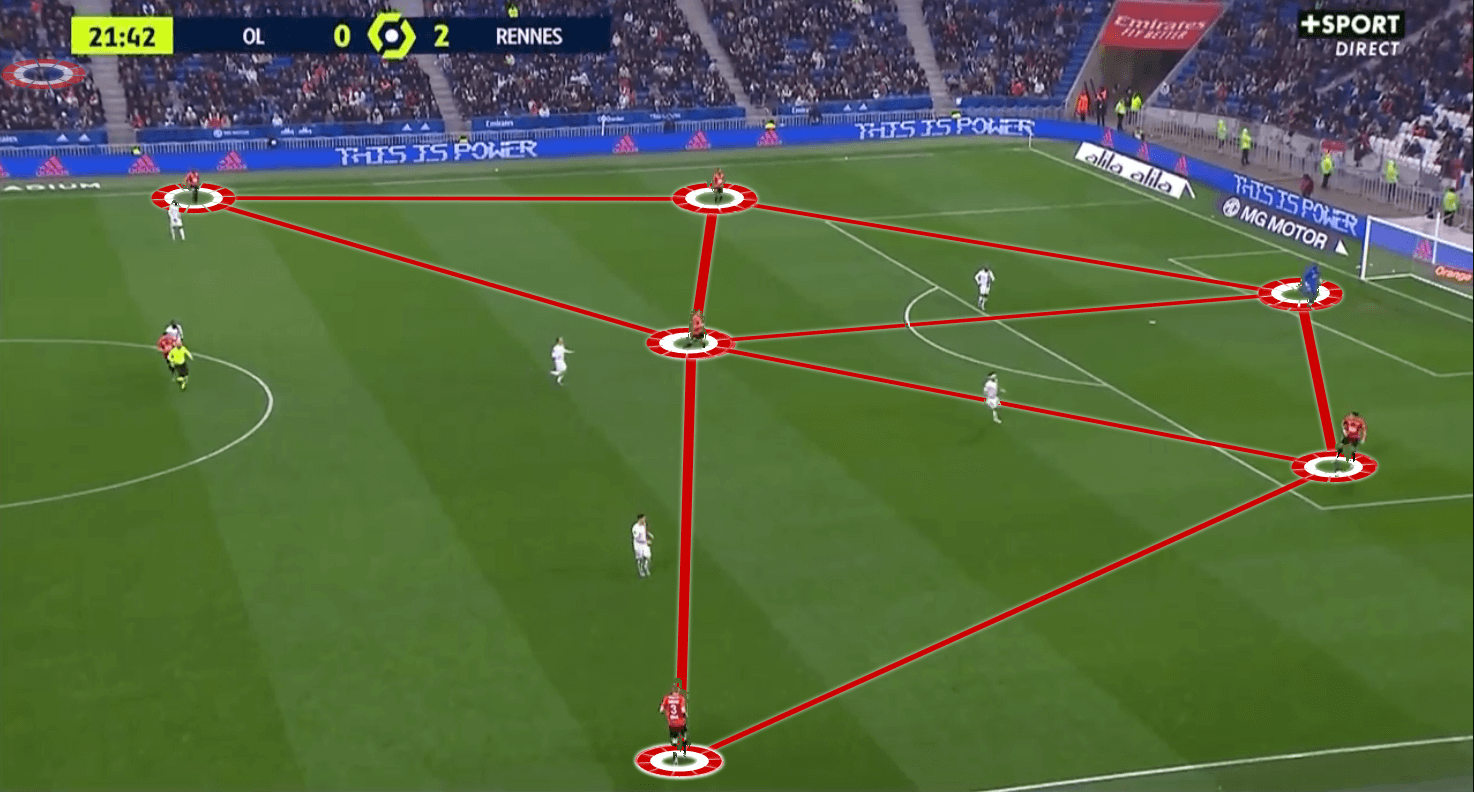
Baptiste Santamaria drops into the defensive third, playing a key role within the build-up. This has enabled the Rennes centre backs to split wide, so the goalkeeper has three passing options.
The full-backs push beyond the defensive line and remain wide. As you can see, due to Santamaria dropping into the defensive line, each player will always have multiple options available for ball progression and ball retention. The image shows the four triangles that have been created by the team’s shape.
I have provided another example below, showing Rennes’ build-up play, this time against Troyes. Baptiste Santamaria has once again dropped centrally to create a pivot and a third option for the goalkeeper. The centre backs have split, and the full-backs have pushed high and wide. This time, the other two central midfielders have dropped deeper.
This has allowed Rennes to create a diamond shape in the wide areas. Like the triangle, creating a diamond shape in possession provides the ball carrier with multiple options and a vertical pathway.
Rennes now have the possibility of three overloads during their build-up. They have a 4v2 overload in both wide areas and a 3v2 overload centrally.
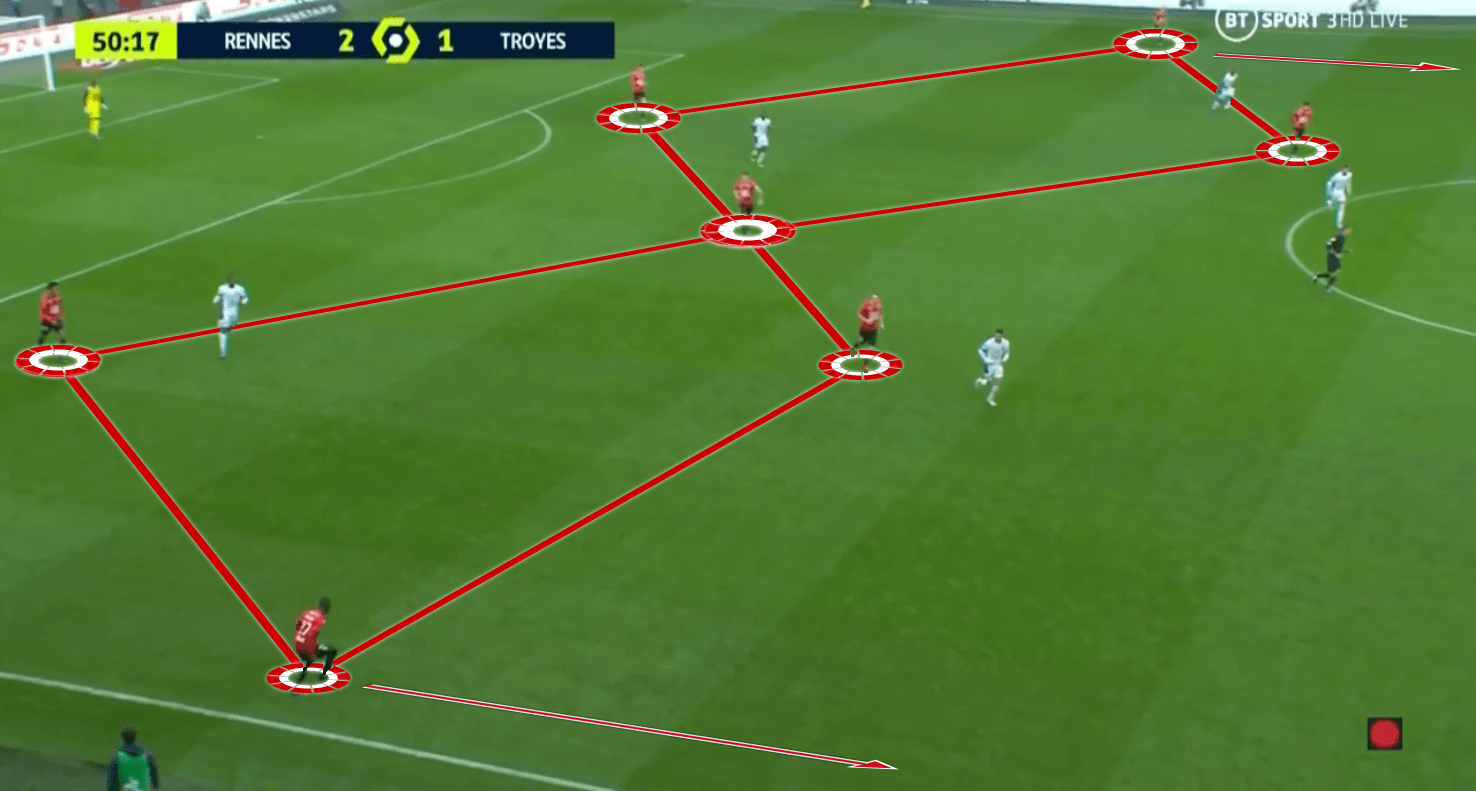
Each example shows that Lyon and Troyes both have five players in Rennes’s half. The benefit of building up with this approach is that it draws the opposition in further towards the ball. Using the full width of the pitch as Rennes do means that the opposition must cover more ground when attempting to win the ball. This makes it difficult to press high as a team, creating disruption in the opposition’s shape and leaving big spaces behind their midfield for Rennes to attack. As we have mentioned in this analysis already, creating and exploiting space is a pivotal part of Bruno Génésio’s tactical approach.
Attacking Shape
When attacking in the final third, Rennes like to attack with variety and flexibility. Bruno Génésio has used different formations this season but regardless of shape, the principles of his tactical approach don’t change.
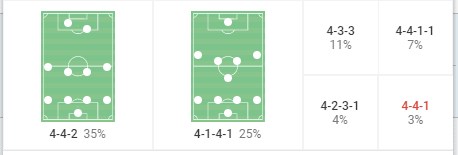
Rennes tend to sit in the above formations when they don’t hold possession of the ball. During the attacking phase, you will often see Rennes transition into shapes that allow them to dominate play in the opposition’s half of the pitch.
Rennes’ transition into an attacking shape often leaves them playing in an asymmetrical 3-2-5 or a 3-1-6. They don’t like to have too many players in the same vertical or horizontal lines
They look to surround the opposition’s defensive line in numbers, with plenty of options to rotate and move in behind the defence and midfield. The rotation and movement will pull the opposition’s defenders from their defensive line and enable Rennes to attack space.
In this scenario below, Martin Terrier has dropped to take the ball off the centre back. He then dribbles around the Troyes midfielder. The moment he does this, the movements of the front five during this attack are as the arrows indicate.
Both Gaëtan Laborde and Serhou Guirassy drop between the lines while both Lovro Majer and Birger Meling look to run in behind. At the same time, Hamari Traoré provides a wide outlet on the right-hand side.
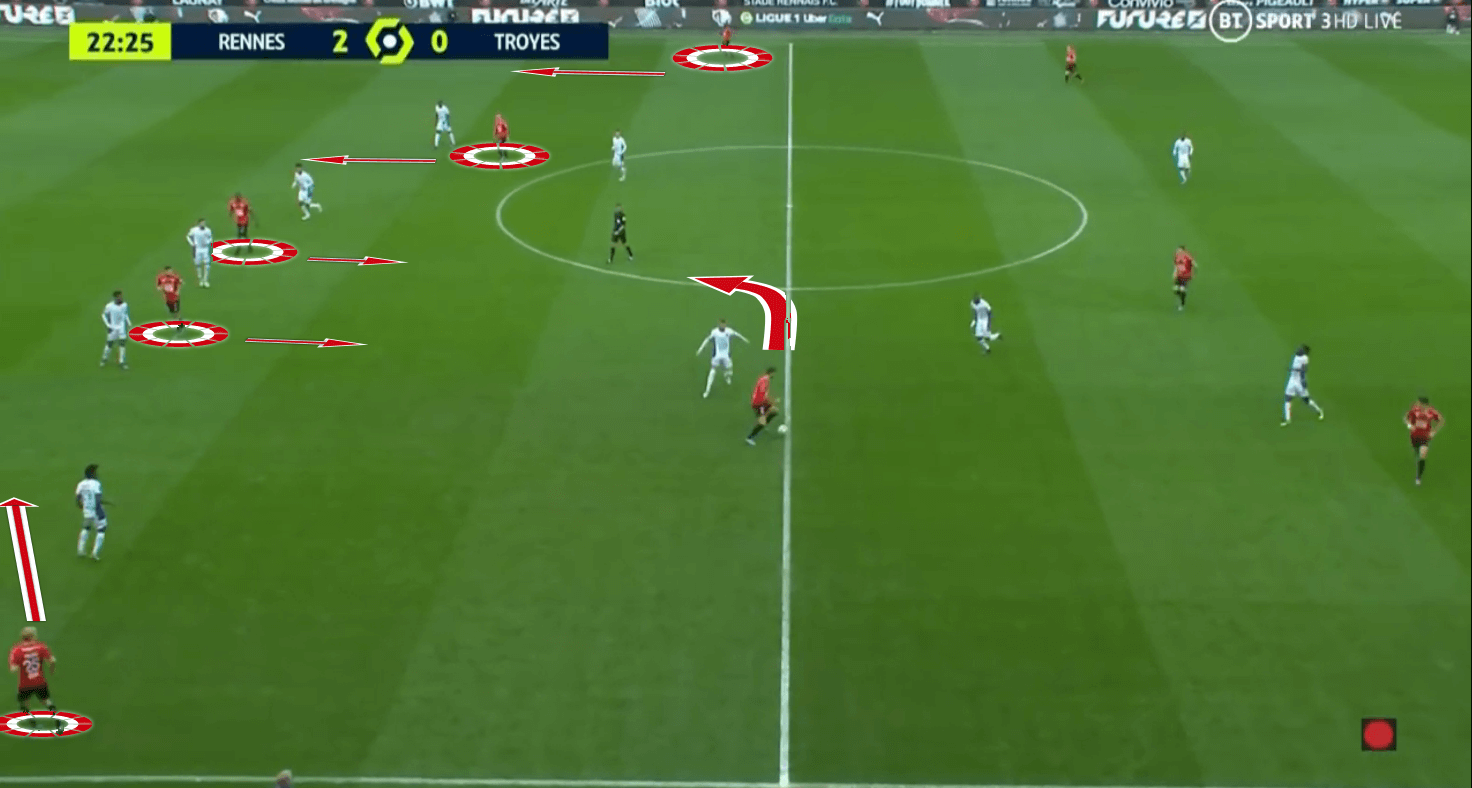
Attacking Width
Rennes’ attack will always have two players making the pitch as wide as possible. They like to pass and move with quick short passes. They tend to channel their attacks through the channel they are occupying at that specific point
Having two players holding the width enables them to be able to switch the play if that channel is cut out by the opposite team at any stage.
This provides variety to their attack and helps them provide a counter solution to different strategies that the opposition may present.
For example, if they come against a team playing a low block it shifts them from side to side. This can create space down the side of each player rather than behind them. If the opposition looks to counter-press, they will get drawn towards the ball. Inevitably, this leaves one area of the pitch exposed, which can lead to 1v1 situations or even open the possibility for an attacking overload
This example shows Rennes attacking high up the pitch in a 3-2-5 shape. They have two players positioned in both the wide channels and one player positioned in the half-space. The five players in the line of attack help Rennes to counter the narrow 5-3-2 block that Angers SCO are positioned in.
The arrow indicates the ball trajectory, and you see Rennes are switching the play to take advantage of the space on the right-hand side.
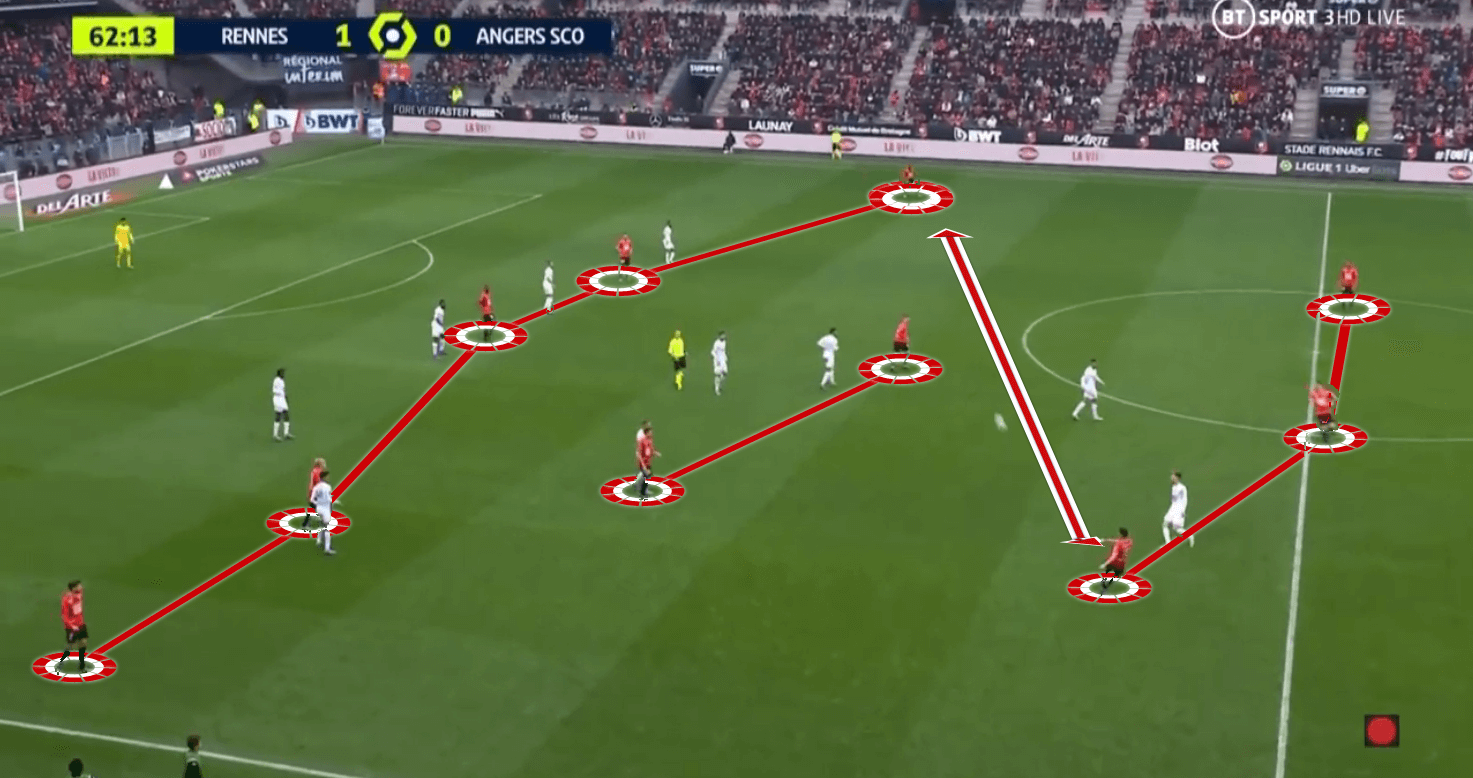
Attacking Set Pieces
Domestically, Rennes have the best attacking output from set-pieces in 2021/22, creating 14 goals from such situations. After reviewing Rennes’ attacking set-pieces this season, there is one apparent feature used throughout — movement.
Their attacking corners are primarily taken by Benjamin Bourigeaud and Lovro Majer. The corners are structured the same way with an identical approach regardless of whether they’re being taken from the left or right or if the taker is left-footed or right-footed.
They always have one player providing the short option and six players attacking the six-yard box. The six players will set up an overload in one area. This creates space on the opposite side of the six-yard box which the opposition tend to leave open because of the three Rennes players crowded in the same area, see the following images for examples.
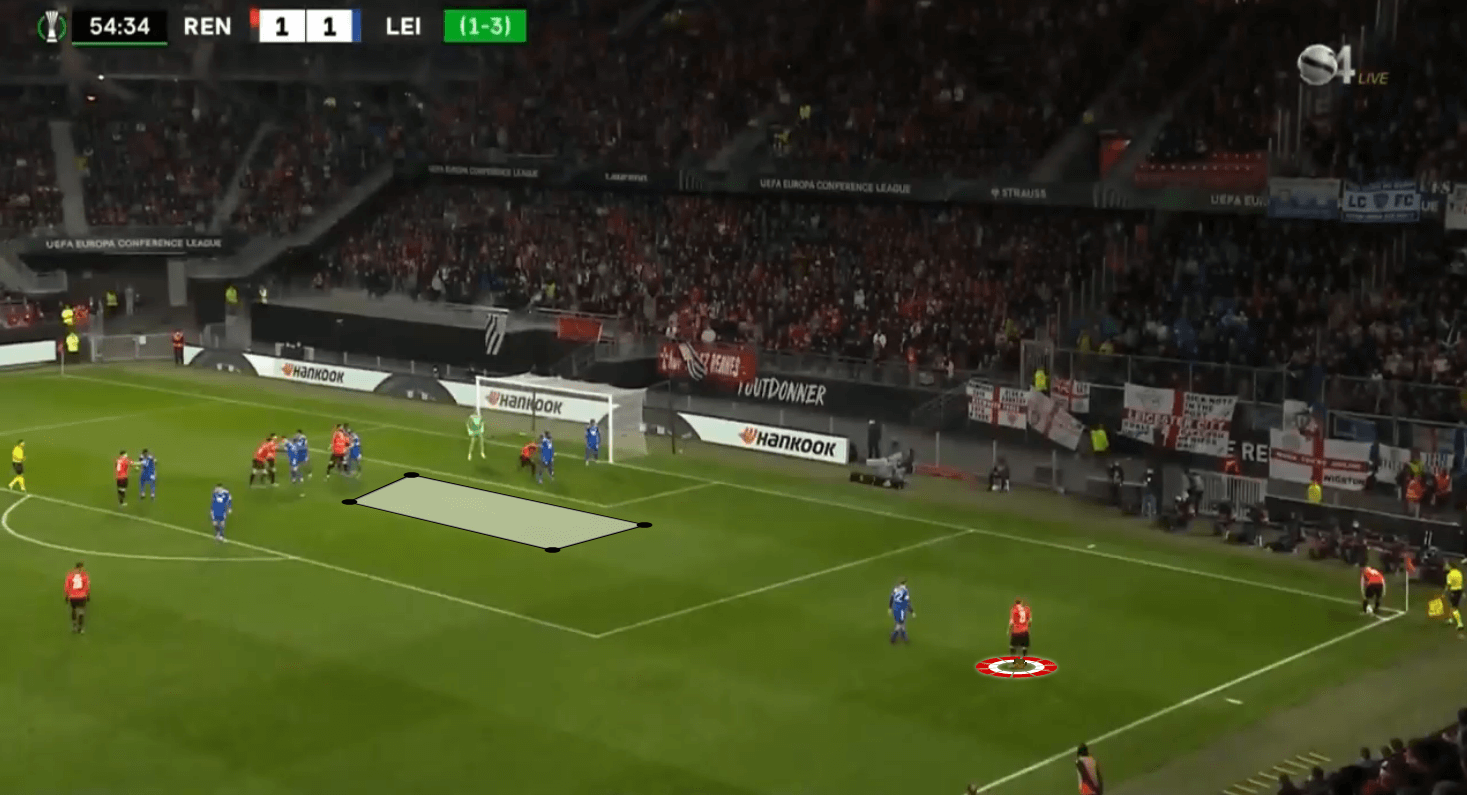

It’s from this point that the movement from the six players in the penalty area proves to be vital.
Rennes don’t aim for a certain area or a particular player on every corner; the taker will vary his delivery between the near post, back post and the centre of the six-yard box. They pose a threat because movement provided by the players is set for any area.
You can see below they have vacated the space towards the back post once again. They have three players crowded together centrally and one player on the front post. The arrows indicate the movement provided. The player at the front post makes a quick run to the front of the six-yard box and pulls two Leicester City players with him. The two Rennes players positioned the furthest back then rotate positionally and the three main players attack the space in front of the goalkeeper. The movement they create from this corner covers all the danger points in the penalty area.
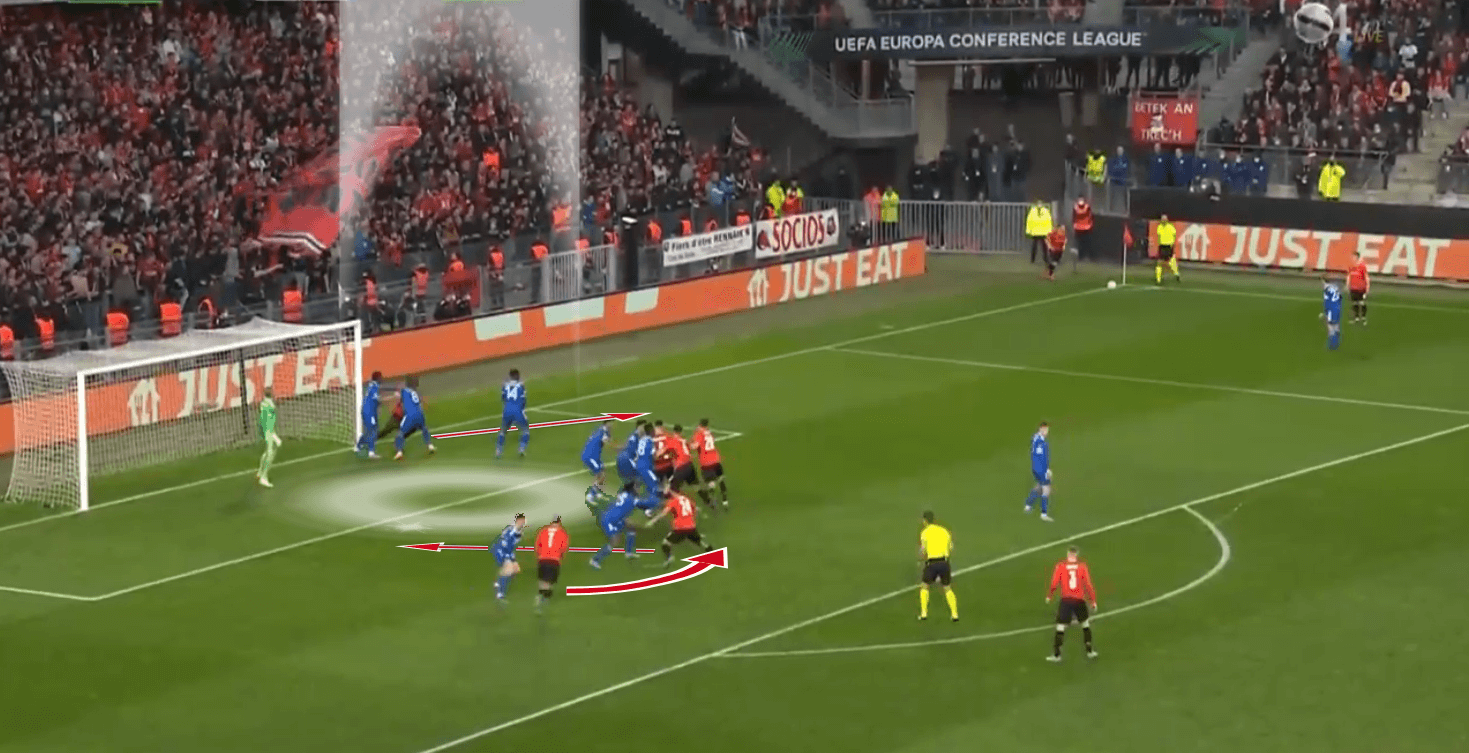
There is no doubt the players will know what’s coming via communication but from a defensive standpoint, any opposition team will find this difficult to contend with.
Their attacking free kicks tend to be more common. Rennes do like to cross the ball and get the ball into the penalty area from both sides. As with their corners, they like to provide movement around the penalty area with players providing the short option.
However, these runs are not to divert the opposition away from the ball like their attacking corners. They like players to make late runs into the penalty area for the second ball and a flick-on.
You can see in this image that the two players are positioned on each side of the penalty area. When the free is taken, I have marked the image with an arrow showing their movement and finishing point on the set-piece. The free-kick is delivered to the area marked out.
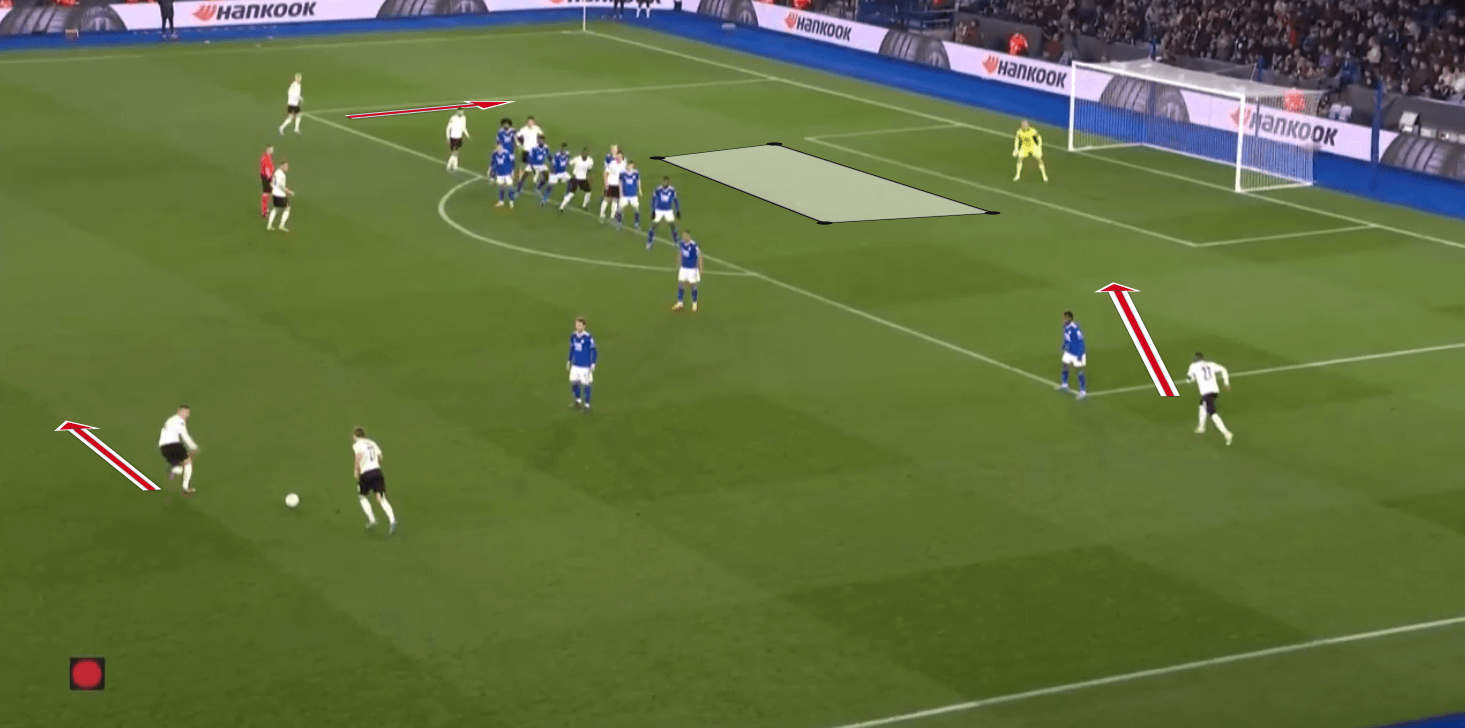
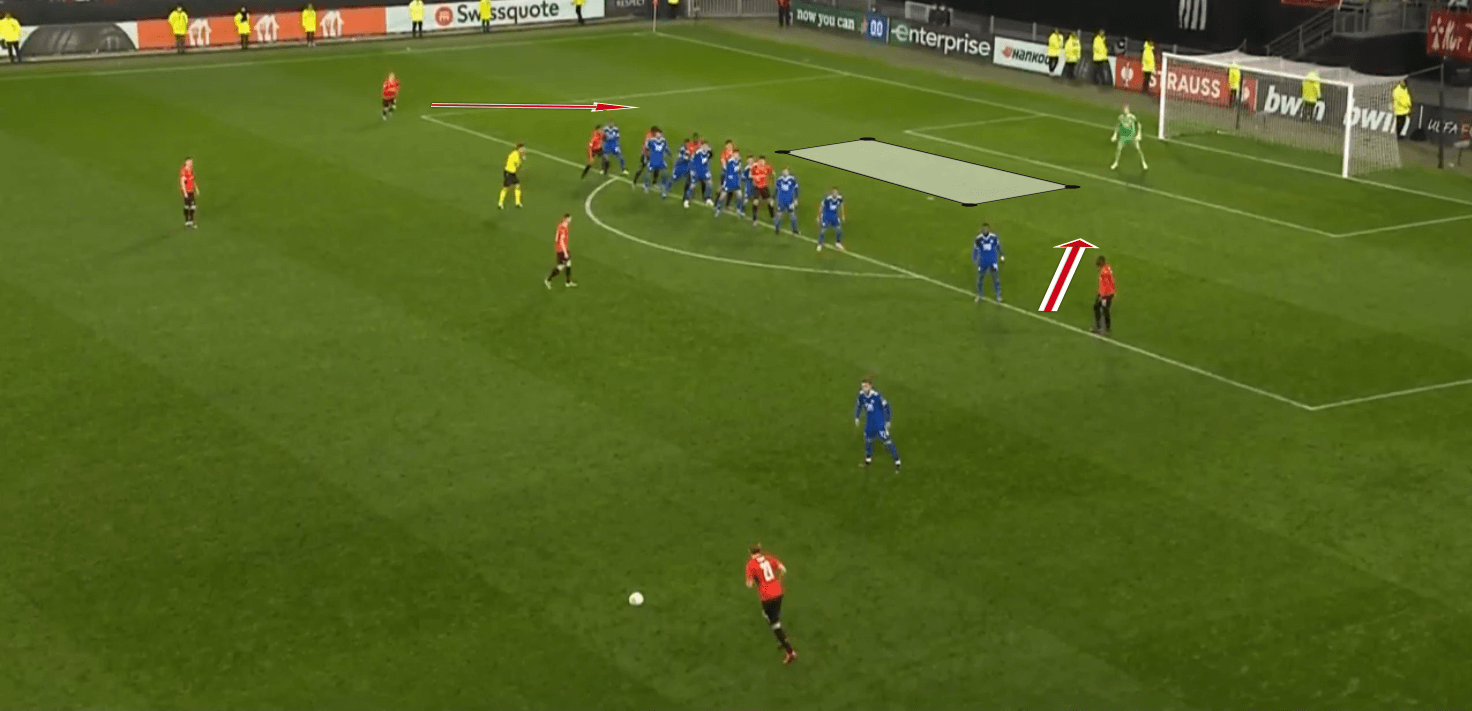
Rennes attacking set-pieces have been one of their successes this season, even though their game doesn’t entirely revolve around set plays. When Rennes fail to score directly from a set play, they see that as a starting point to continue attacking. The players who are not involved in attacking the penalty area should position themselves around the penalty area to be able to press the opposition if the ball is lost.
It’s clear that Rennes see them as an opportunity to maintain pressure in the opposition’s half.
Defensive Phase
Teams who like to dominate the ball and control the game through possession still require a defensive structure to be able to regain possession. It’s the defensive structure that a team implements that assists their ability to play progressively when they have the ball.
Rennes are no different. They are an attacking team who like to control the play through possession. However, the defensive structure they play with under Bruno Génésio’s leadership is no different to any other team that plays possession-heavy football effectively; they look to make the pitch as small as possible both vertically and horizontally.
Rennes’ defensive transition when they lose the ball is different depending on the area in which they lose it.
If the opposition has possession in the Rennes attacking third, Rennes like to counter-press. If the ball isn’t won back immediately, they continue to press with intensity. This tends to see one player pressing the ball whilst the other players get set to press the other possible passing options and look to mark the opposition tightly.
You can see here how Lyon, after winning the ball, have utilised the goalkeeper. Look at the position of Rennes’ players. All outfield players are in Lyon’s half with every player within close proximity of a Lyon player, ready to attack the ball.
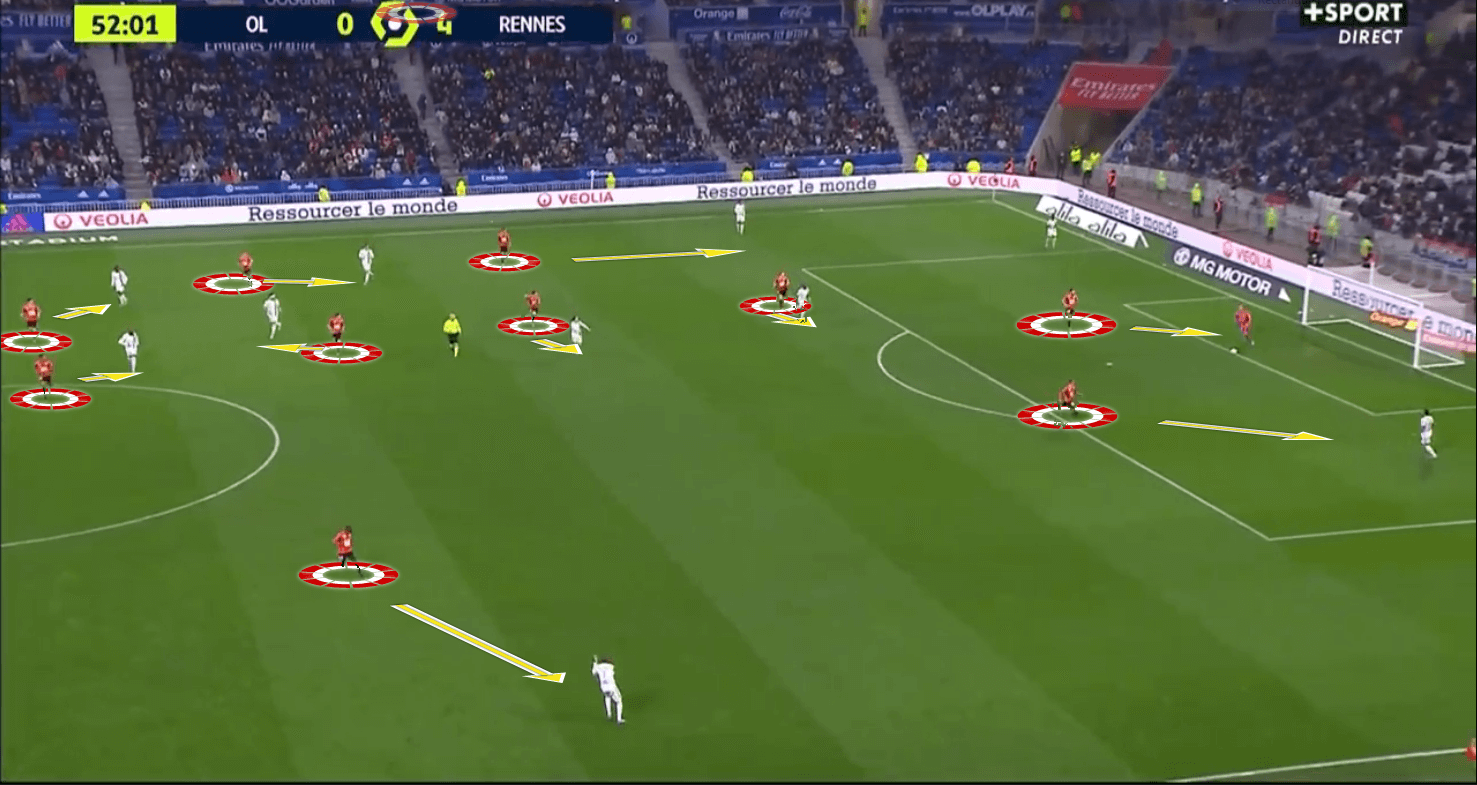
You can see in the example how the defence changes because of where Lyon have the ball. At this point, Lyon managed to progress the ball to the middle third of the pitch. Rennes have now switched to a 4-4-2 block keeping the distance between each line and each player at a minimum, making it difficult for any opposition to play through the centre of the pitch.
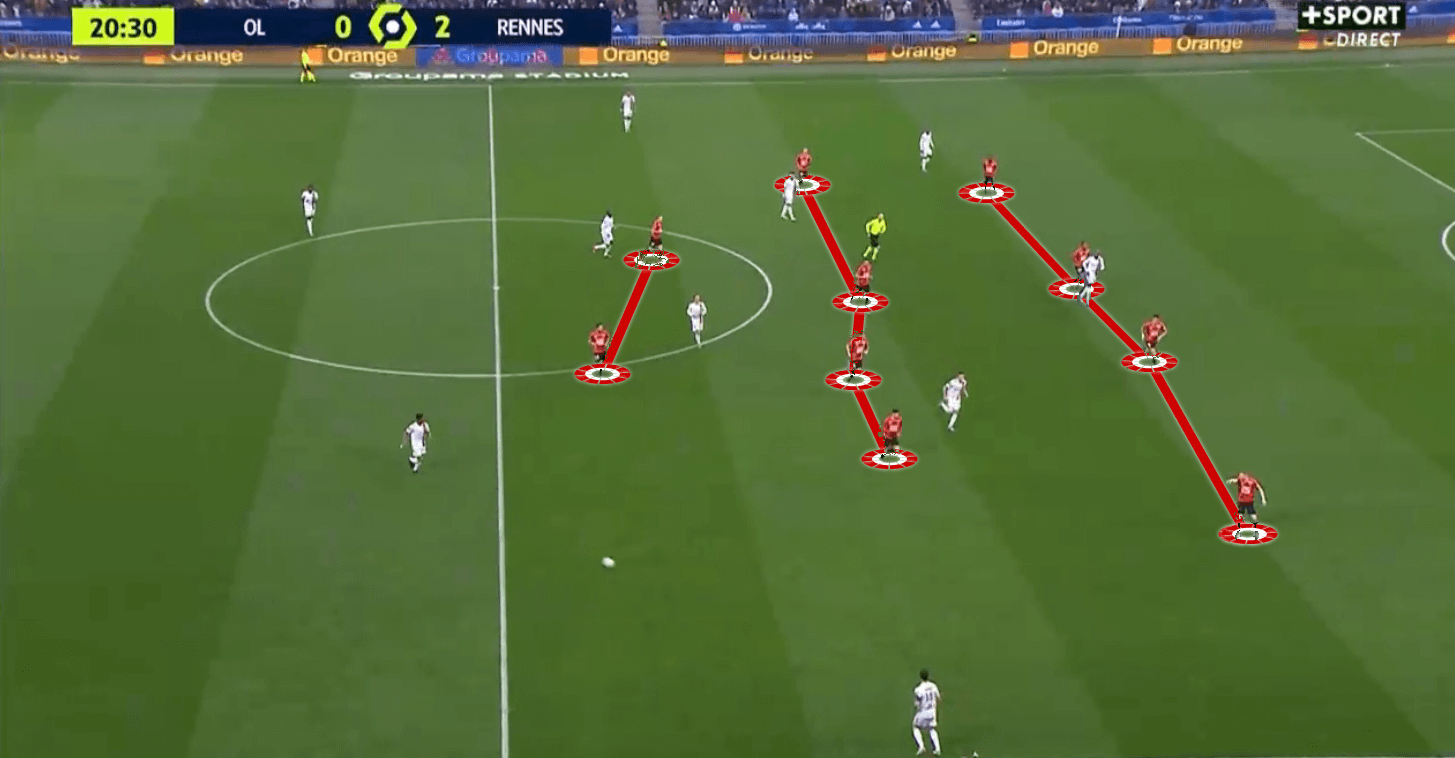
This type of block remains as such if the opposition manages to progress the ball into Rennes’ defensive third. The main aim of their defensive structure is to force the opposition out wide and away from goal. Controlling the space centrally is the key to a defensive block as the central spaces give away the best chances.
Rennes still look to press in their own half, but they do it individually and zonally. Each player will press as and when the ball comes into their area of the pitch. While the other players will look to stay compact and maintain their shape.
Conclusion
There’s no doubt that Rennes’ season so far has been productive. Bruno Génésio has instilled a clear identity that is entertaining and produces very good attacking football. The players have clearly adapted well to this approach.
This analysis shows what I’ve identified as being some of the main aspects within that tactical approach. Along with being the key components to Rennes performance.

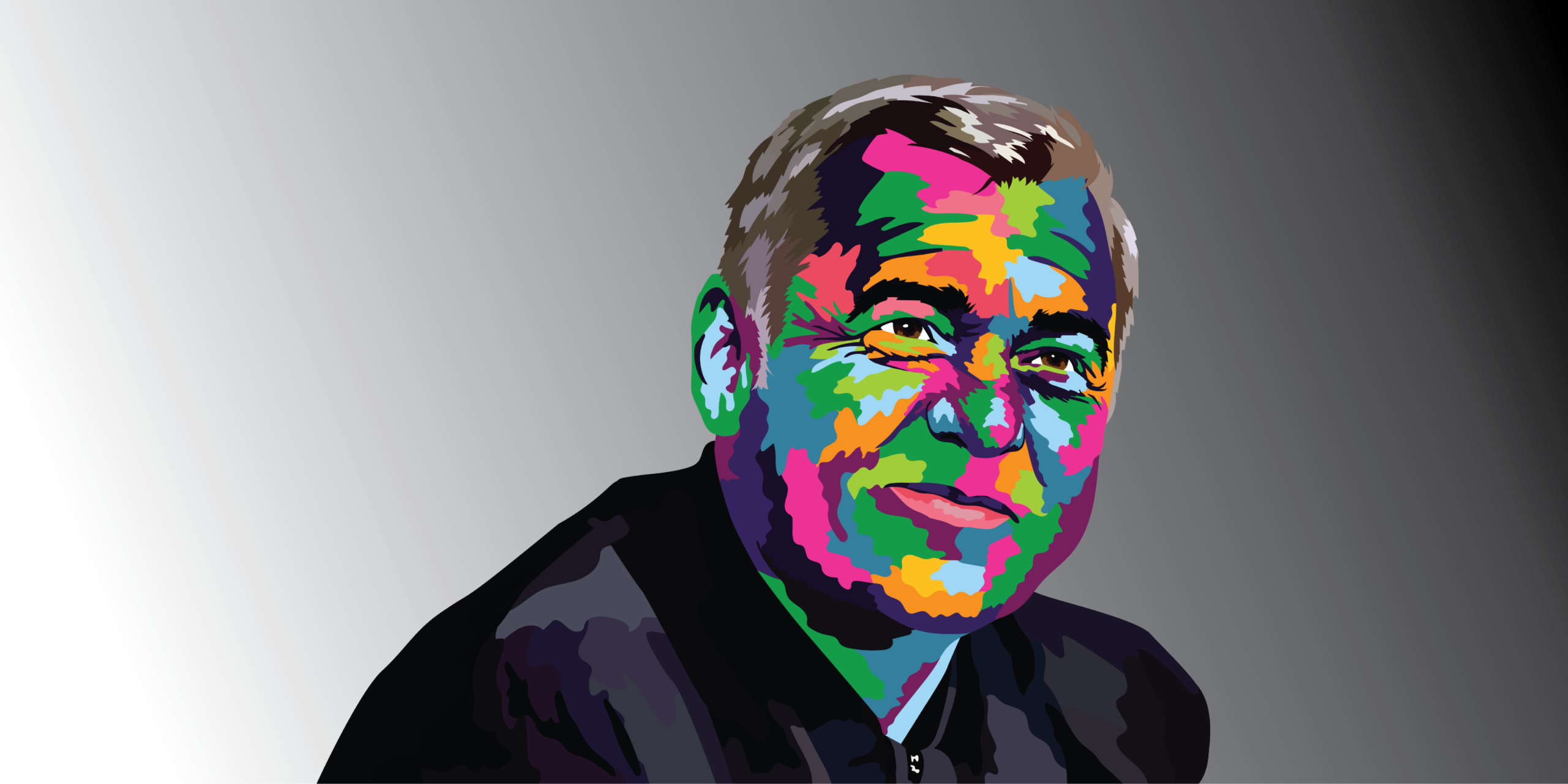

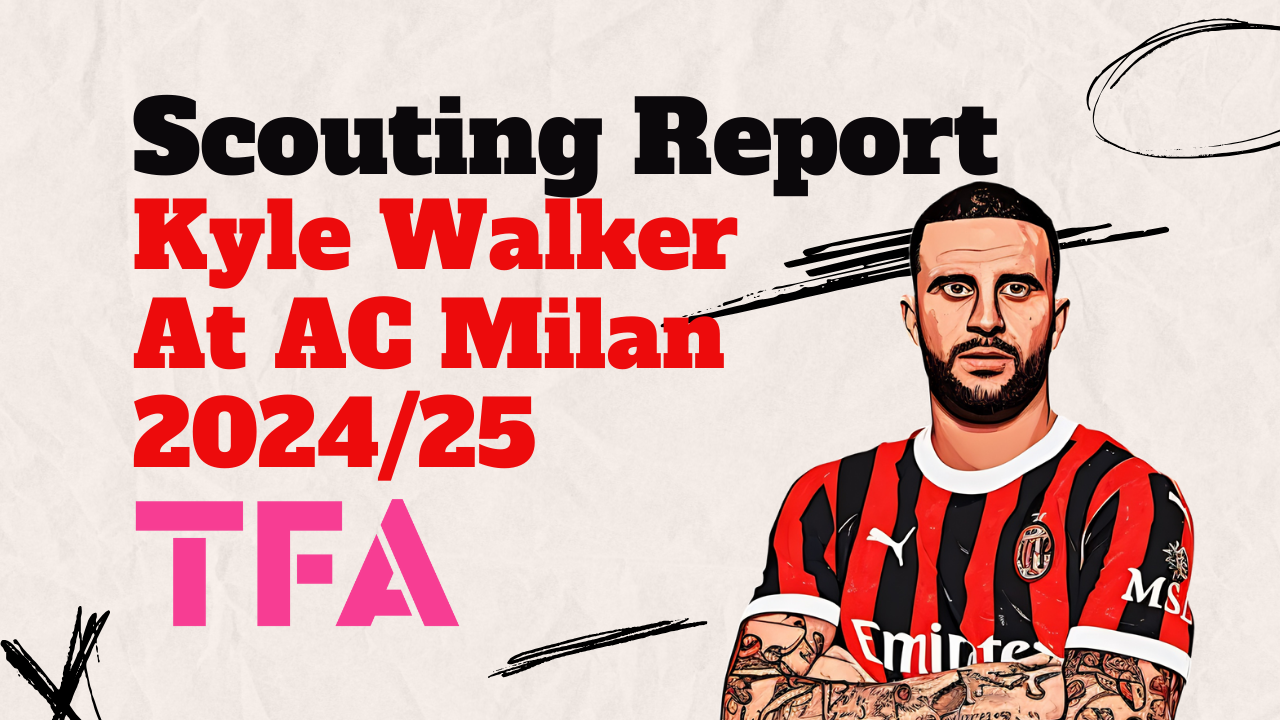
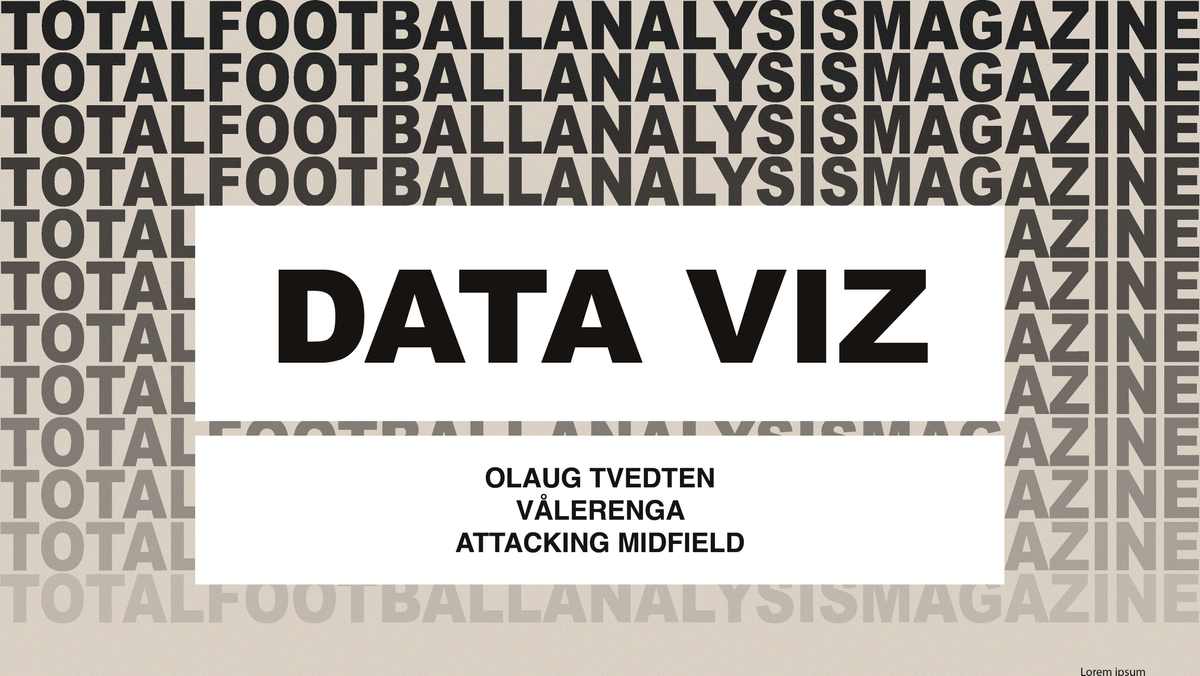
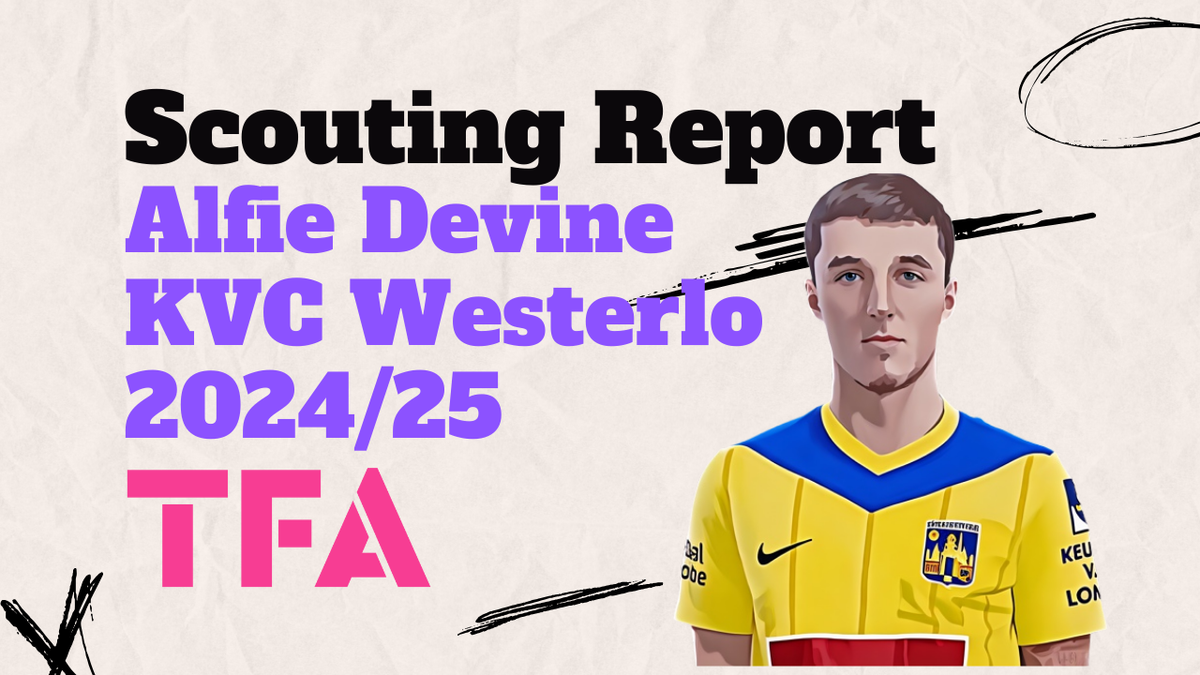
Comments